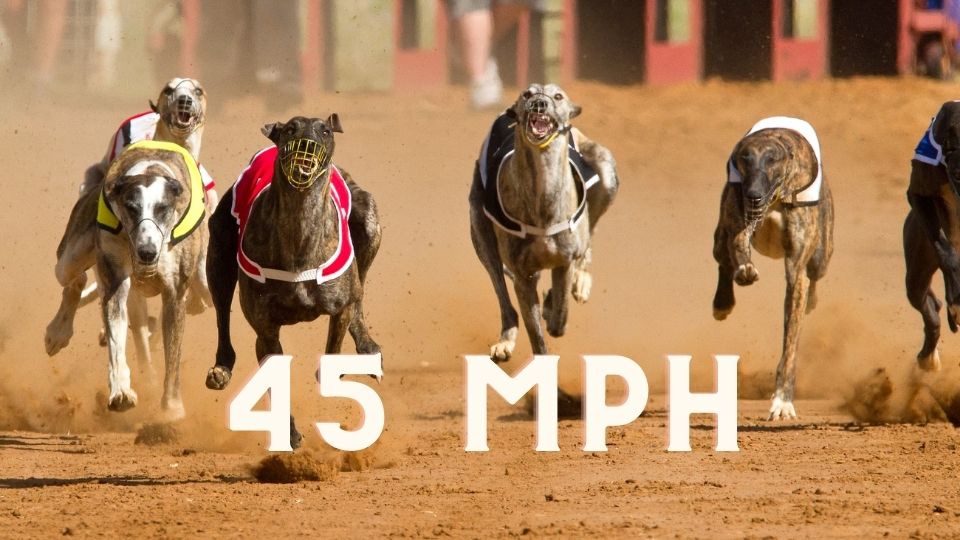A Greyhound, widely recognized for its agile form and graceful movements, can achieve a top speed of approximately 45 miles per hour (72 kilometres per hour). This makes the fastest breed of dog in the world, noted especially for its exceptional acceleration capabilities.
Greyhound Speed in Context
Compared with the speed of humans and other animals, a Greyhound’s speed is impressive. The fastest human sprinter, Usain Bolt, set a world record with a speed of 27.8 mph, which is significantly less than what a Greyhound can achieve. Here’s a comparison table to put the Greyhound’s speed in perspective:
| Species | Top Speed (mph) | Top Speed (km/h) |
|---|---|---|
| Greyhound | 45 | 72 |
| Cheetah | 58-61 | 93-98 |
| Pronghorn Antelope | 55 | 88 |
| Usain Bolt (Fastest Human) | 27.8 | 44.7 |
Anatomy and Physiology of Speed
Greyhounds are naturally built for speed, attributing their exceptional running prowess to their unique anatomy and physiology. They have a streamlined, aerodynamic build, long legs and a flexible spine, which lets them cover more ground with each stride. They also have a large heart, highly efficient lungs and lean muscles, making them ideal endurance runners.
The Science of Sprinting
Greyhounds are classified as sight hounds, which means they primarily rely on their keen sense of sight to spot and chasing down potential prey. When they do run, they exhibit a type of gait known as a “double suspension gallop.” With this gait, all four of the Greyhound’s feet are off the ground not once, but twice during each stride. This is an attribute that allows them to utilize their full potential speed.
Greyhound Racing
Greyhound racing became popular in the United States as a form of legal wagering. In a typical Greyhound race, dogs chase an artificial hare around a circular or oval track until they reach the finish line. The average race length is between 550 and 660 yards (503 to 603 metres), with the fastest dogs completing the courses in less than 30 seconds.
Contrary to popular belief, racing does not inherently harm Greyhounds. The breed loves to run and chase, and appropriately monitored and managed racing allows them to do this in a controlled environment. However, it is the treatment of the dogs both on and off-track, along with unethical breeding practices, that has led to criticism and controversy surrounding the sport.
When considering a Greyhound’s top speed, it’s not just about sheer numbers. It’s about the unique physiology that allows them to achieve such speeds, their reliance on keen eyesight to spot targets, and the exhilarating activities, such as Greyhound racing, that capitalize on their speed.
Key Factors Determining a Greyhound’s Speed
Several key factors can influence how fast a Greyhound can run:
- Age: Younger dogs are typically in better physical condition to achieve top speeds. As a Greyhound ages, its speed is likely to decrease.
- Health and Fitness: Just like humans, a healthy and fit Greyhound will usually run faster than an unhealthy or unfit one. A dog’s general health, including its weight, muscle condition, and metabolic health, can significantly influence its speed.
- Training: Trained Greyhounds can reach higher speeds than those that have not undergone training. They are more accustomed to running at high speeds and can maintain their top speed for longer.
- Temperament: Similarly, a dog’s temperament can determine its speed. Excitable and energetic dogs might reach higher speeds due to their enthusiastic nature.
- Environment: The environment in which Greyhounds run can also affect their speed. For instance, they may run slower on uneven terrains or in hot weather.
Speed Training for Greyhounds
Speed training for Greyhounds is a process that involves a focus on several core areas:
- Sprinting: Usually, this involves short, vigorous exercise periods where the Greyhound runs at full speed.
- Endurance training: Although Greyhounds are more built for speed than endurance, they also need to maintain a good fitness level, which means exercising for longer durations at a moderate pace.
- Recovery: This includes proper rest and nutrition after training, which is essential to help muscles heal and gain strength.
Benefits and Risks
Running at high speeds is a natural and healthy activity for a Greyhound. It provides them with both physical exercise and mental stimulation.
However, because of their high top speed, Greyhounds may also face certain risks, including:
- Injury: Running at high velocities may lead to injuries, such as pulled muscles, paw injuries, and even more severe damage if they lose control while running.
- Overexertion: Greyhounds that are pushed to run faster than their abilities or without proper conditioning may experience overexertion, leading to possible health issues.
Performance Comparison within the Breed
Performance among Greyhounds can vary, with some dogs recording significantly faster speeds than others. Here is a comparison table of average speed, recorded over 100 meters:
| Gender | Average Speed (mph) | Average Speed (km/h) |
|---|---|---|
| Male Greyhound | 45 | 72 |
| Female Greyhound | 41 | 66 |
Even though Greyhounds are classified under one breed, there is still a range of capabilities among individuals. It is important to remember that these are average numbers, and speeds can differ based on various factors.
As we have seen, understanding the top speed of a Greyhound involves considering various elements such as anatomy, racing history, factors influencing speed, and risks and benefits. This well-rounded view helps create a more comprehensive understanding of this remarkable breed’s speed.




